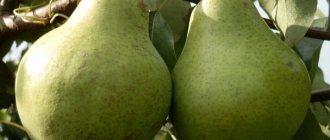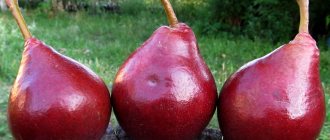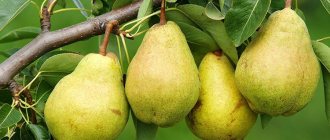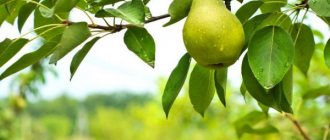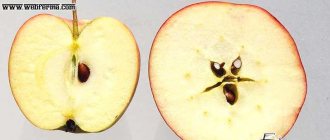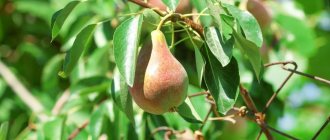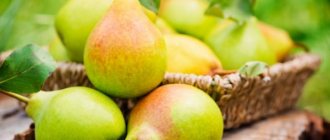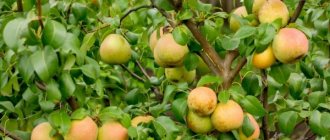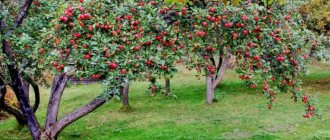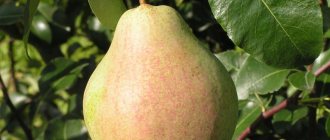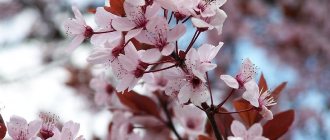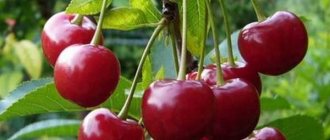Pear Elena.
Description of the variety
Elena is a winter pear; the fruits ripen at the end of September and can be stored until the end of January. The tree itself is stable and unpretentious, and has a bountiful harvest.
Characteristics of wood
The culture is medium-sized, up to 3 meters high. The young tree grows quickly, but growth slows down towards the fruiting period. The crown is pyramidal, slightly spreading, of medium density.
Pear Elena.
Description of fruits
The fruits are round, pear-shaped, with an average weight of 140 to 220 grams. They are colored green with a faint blush on the sunny side, with a small number of gray subcutaneous dots and small rusty spots. When ripe, pears turn yellow-green.
The pulp is dense, juicy, semi-oily, white. The taste of the fruit is sweet and sour, with a slight tartness and a weak aroma. Tasters highly appreciated the taste of the fruit - 4.6-4.8 points out of 5 possible.
Pros and cons of the Elena variety
The disadvantages of pears are few:
- overripe fruit quickly falls off;
- with a large amount of harvest, the fruits grow in different shapes;
- average winter hardiness.
Otherwise, the Elena variety has more positive aspects:
- juicy and nutritious fruits;
- resistance to frost and spring frosts;
- high fertility;
- attractive presentation;
- late ripening;
- long shelf life of fruits;
- high resistance to diseases and pests.
Pear fruits are suitable for transportation, but only over short distances. The pear has average drought resistance; the fruits have a universal purpose for consumption.
Reviews
We have an Elena pear growing in our dacha. The tree is compact, does not take up much space, but collects 5-6 buckets of pears. I use them to make jam and compote for the winter. And we eat the rest of the harvest almost all winter.
Alexandra
Yasnogorsk
There are several pears growing on my plot, the Elena variety is winter. In our area, it tolerates winter well and hardly gets sick. The pears last until February. My wife also makes jam, puree and filling for pies from overripe fruits.
Stanislav
Zemlyansk
My husband and I bought a plot of land and planted a garden. We have different fruit trees growing there, the Elena pear variety is already bearing fruit. The fruits are very tasty, they just melt in your mouth. The tree is small and can be well cared for by pruning, spraying and harvesting.
Lydia
Alekseevka
Planting and caring for pear Elena
The time for planting the Elena pear variety largely depends on the climatic conditions of the planting region. In the southern part of the country it is better to plant in the spring, when the first buds bloom. In the Central region or in the homeland of the fruit tree, the variety is planted in October. Gardeners recommend choosing two-year-old seedlings. Before planting, the tree is immersed in water at room temperature. They are also examined for signs of root cancer. The seedling should have many side shoots, so the tree will root quickly.
Landing rules
2-3 weeks before planting, the area is cleared of excess growth. The soil is dug up and loosened. The planting hole is dug 70 cm deep, the hole is dug up to 50 cm in diameter. Drainage is poured to the bottom. Part of the excavated soil is mixed with fertilizer, compost and poured in a heap after a layer of drainage. If necessary, add sand or lime, which will reduce the acidity of the soil.
The roots are evenly distributed over the hole, and if necessary, add soil to avoid root entrapment. The residual soil is also mixed with compost, mineral fertilizers and the seedlings are covered in layers. After compacting the soil, a root ditch is made. Next, the pear is watered with a bucket of water and mulched with dry sawdust or peat.
Important! When planting a young seedling, do not mix the soil with fresh manure. It burns out the root system of the pear.
Watering and fertilizing
Both a young seedling and an adult tree of the Elena variety require a large amount of moisture. The soil should not be too wet; you just need to water it as the mulched surface dries. In the summer season, the seedling is watered every other day. One adult pear tree requires up to 3 buckets of water.
Before preparing the seedling for winter, water the pear abundantly with water. The moisture should get as deep as possible so that during frosts the ground does not freeze and the roots receive nutrients all year round. After wintering, the pear is again filled with plenty of water.
Fertilizing with minerals is carried out once every few months from the moment the seedling is planted. In the second year of growth, the first feeding is done with mineral fertilizers. Growing on black soil, pears do not require fertilizing, but compost must be added when planting. Closer to winter, phosphates and organic fertilizers are added to the soil.
Trimming
Branches are pruned in the spring. As soon as the winter cover is removed, the tree shelter is inspected for the presence of frozen branches. The crown is formed by pruning branches at the initial stage of pear growth. Thinning is done both in winter and spring.
Advice! Young branches of the Elena variety always produce a harvest, so it is recommended not to prune them.
Whitewash
Whitewashing is carried out until the first frost. A solution of slaked lime will protect the tree bark from sunburn, freezing and serious cracking of the bark. Mostly they whiten in the fall, then re-whiten in the spring. The third time is whitened in the summer, when the pear is about to bloom. Usually the entire trunk is whitewashed or whitened down to the lower skeletal branches. The young tree is whitened up to half the trunk.
Preparing for winter
The seedling is prepared for winter after all the leaves have fallen. First, the space is cleared of withered leaves, then watered abundantly. The readiness of a tree for winter depends on the amount of water received. During the year, if there is a lack of moisture and a bountiful harvest is obtained by winter, the pear will be depleted, so it may not tolerate frost well.
Next, pruning is done, diseased, damaged and dry branches are removed. The young seedling is covered with an awning or cloth, and the trunk is covered with dry straw. In an adult tree, the trunk is wrapped in burlap or cardboard. Protruding roots are covered with straw, roofing felt or spruce branches.
Landing
The Elena pear variety is planted in many territories of Russia and its environs. It adapts well to climate changes and different soil types. You can read about how to properly plant Elena pears in the selection of articles below.
How to plant a pear tree correctly
At what distance to plant pears?
How to choose pear seedlings
How to replant a pear
Winter pear varieties - choosing the best option for planting in the country
If you need to quickly and correctly choose a tree for your dacha or home, we bring to your attention a list of the most popular varieties in Russia.
Bergamot Mleevsky. A very recently bred variety that has very good characteristics: increased winter hardiness (withstands frosts down to -37-42 degrees), high yield, excellent taste. From one 10-year-old tree you can collect up to 400 kg of fruit, and it begins to bear fruit much faster than its competitors - with proper care, you can taste the pear in just 3 years. The fruits are of medium size, weighing about 250-300 grams each. Technical ripeness begins in mid-October, and by early November all pears become ripe, soft and have a very sweet taste. Pear Bergamot Moscow. This is another recently developed variety that has excellent yields. It is listed in the register of fruit trees recommended for industrial cultivation. Up to 300-400 kg of pears can be harvested from one tree, and they are dense enough to be transported and stored for a long time. Moscow Bergamot is completely different from Mleevsky, despite their similar names. The fruits are small, weighing up to 150 grams. Technical ripeness – early to mid-November, preferably collected before the first frost. Pear Hera. An excellent option that has all the necessary characteristics for growing in our latitudes. Its main advantage is winter hardiness - down to -48 degrees, due to which the tree is widespread in many northern regions of Russia. The first fruits can be obtained no earlier than 7 years after planting, and by the 15th year the tree can already produce excellent yields of up to 500 kg. It does not require any maintenance, the only thing that needs to be monitored is the formation of the crown, since too many unnecessary shoots are formed inside the main trunks. Grows on loamy soils, black soil, does not like peat and wetlands. Germain. One of the best varieties ever found in our climate zone. In terms of its taste, it is No. 1 for many summer residents, as it has a slight aftertaste of duchess and has extremely juicy fruits that immediately melt in the mouth. Distributed in the southern regions of Russia, Ukraine, Moldova
The yield, unfortunately, is not great - no more than 200 kg per tree, but the important thing here is quality, not quantity! Winter Kremlin pear. Withstands up to -35 frost, begins to bear fruit quickly - after 4 years the first fruits, after 6-7 years you can get up to 50 kg per tree, and already at the age of 15 years it begins to bear fruit in full force. The taste deserves 5 out of 5 points - the pears are juicy, slightly firm, have an excellent smell that cannot be compared with anything else
The weight of one fruit reaches 300 grams, but the average weight does not exceed 170-210 grams. Pear Maria. Ukrainian selection, but currently grown in Poland, Belarus, and temperate Russia. The fruits are large, up to 400 grams (average - 245 grams), the variety is winter-hardy and can easily withstand frosts of -45 degrees, which is why it is planted by gardeners in the northern regions. It is perfectly compatible with quince, it bears fruit already in the third year, but a good harvest should be expected only after 6-7 years at least. It has great industrial value, as it is perfectly stored and transported at the stage of technical ripeness. When biologically ripe, the fruits become very soft and juicy, but are extremely difficult to transport (the fruits are crushed). Grusha Yakovlevskaya. It was bred on the territory of Russia by Professor Yakovlev, for which it received its name. It has been popular for many years in the markets of Russia, Ukraine and Moldova, and is one of the best exported varieties. It has a high density, sweet taste at the stage of biological ripeness. Its only drawback is that it is sold only at technical ripeness, when it is still quite hard. From the Yakovlevskaya pear you can harvest up to 600 kg when the tree is only 15 years old, and the seedling begins to bear fruit after 3-4 years, and up to 15-20 fruits are formed on the tree.
When choosing trees, you must first of all pay attention to the breeding site or enterprise that sells them, since many varieties cannot be visually distinguished. You should not trust dubious individuals, since raising a good seedling is quite difficult and expensive, so few people undertake it
The only consumer protection is documents provided by the seller, which can at least somehow guarantee the authenticity of the variety.
Care
Agricultural technology for pears is not difficult. Pear Elena is unpretentious and requires only a number of standard procedures - watering, fertilizing and agricultural technology. You can read about all the features of caring for the Elena pear variety using the links below.
How to care for a pear Pruning a pear Pruning a columnar pear Treating a pear from diseases and pests Feeding a pear How to water a pear
Climate and cultivation regions
The variety has good winter hardiness and drought resistance. It reacts normally to temperature changes, as well as to other natural disasters. Elena trees feel great not only in the southern regions, but also to the north - in the Central regions, Volga-Vyatka region, Chernozem region and in the Middle zone.
The most beautiful horse breeds in the world: top 10
This type of pear can also be found in the North-Western District. In more northern regions - in the Urals and Siberia, trees of this species freeze.
Diseases and pests
The Elena pear variety is resistant to scab and septoria. Preventative spring treatments will protect the tree from other diseases. You can read about all protection and prevention procedures by clicking on the links below.
Dangerous Pear Pests
Pears often suffer from pests, they affect the leaves, bark and fruits.
In this article, we have selected 11 of the most harmful insects that harm pear trees, and also ways to destroy them.
Diseases of pear trees
To get what they cherish, gardeners have to work hard, and the reason for this is pear diseases.
Read about 19 common pear diseases and how to combat them.
How to care after planting, possible pollinators
The August Dew pear, like the Lada, is not distinguished by its capricious character. Its cultivation is possible not only in the middle zone, but also far beyond the Urals. The ripening dates will shift slightly, and it is also advisable to provide winter shelter, but in general, further care is not difficult. In winter, it is necessary to regularly clear snow from branches so that they do not break under such weight. In addition, for the northern region it is necessary to consider the possibility of independent pollination of flowers, because flowering occurs very early.
Basic rules for caring for seedlings after planting:
- The pear tree needs plenty of watering, but does not like wetlands. The best way to retain moisture is to use mulch. The layer can be made from straw, peat and humus, as well as specially detailed tree bark.
- Regular loosening can be done along with weeding. It is necessary to loosen the soil at the roots shallowly so as not to damage the shoots.
- Fertilizers must be applied no earlier than three years after planting. Until this time, the necessary supply of nutrients is provided by mineral complexes added during planting.
- Spraying of trees and pruning of branches is carried out approximately twice per season, in spring and autumn. Dry branches are cut off completely, young shoots - by a third of the length. This contributes to the formation of a lush and not dense crown, which allows you to get a good harvest.
- Harvesting is carried out when the fruits are technically ripe. It is recommended to remove pears from trees, because when they fall, there is a high risk of damage to the skin. Picked pears are subject to processing; their shelf life is short and only if placed horizontally on a dry surface.
But this information will help you figure out what a frost-resistant variety of pears for Siberia looks like and what it’s called.
Video shows how to care for a pear tree:
“Lada” is a partially self-pollinating variety, but if there are similar species on the site, it bears fruit much better. The selection of necessary pollinators is carried out according to the following criteria. The first and most important factor is the timing of flowering. They must match completely, otherwise pollination will not occur.
The second important factor is crown size. Trees should be located as close to each other as possible, but not obscured by crowns. The third main criterion for choosing a pollinator is disease resistance. Otherwise, pests or disease may spread from one tree to another.
The following species are considered the best pollinators for the Lada variety:
- Rogneda is a frost-resistant variety with early flowering and fruiting.
- Cosmic is a summer variety, one of the best in terms of yield.
- Severyanka is a winter-hardy variety characterized by early ripening.
- Chizhevskaya is a late variety, the flowering period of which coincides with the proposed species.
- Otradnenskaya - good indicators of frost resistance.
The Lada pear variety is distinguished by high productivity and early harvest. The fruits are universal, suitable for processing and fresh consumption. The basic rules for planting seedlings of this variety, as well as the nuances of further care, are discussed in the information in our article.
This video will also help you understand what the sweetest varieties of pears for the Moscow region look like and what they are called.
Fruit characteristics
The fruits of the Elena variety are always large, uniform and pear-shaped, and ripen by the end of September. There is a bumpy surface, the skin is soft and tender to the touch, sometimes sticky. The average weight of the fruit reaches 200 g. Unripe fruits are yellowish-green in color, fully ripe ones are bright yellow with a pleasant aroma. Gray subcutaneous dots are visible, the stalk is shortened and slightly curved.
The pulp is snow-white when cut, oily and juicy. Tasting score – 4.7 points on a five-point scale, characteristic sourness and sweet aftertaste are felt. The fruits are consumed fresh and often prepared for the winter. The fruits of the Elena variety contain:
- acid – 0.2%;
- sugar – 12.2%;
- fiber and vitamin C – 7.4 mg.
Characteristics
- Elena enters the fruiting period 5-7 years after planting the seedling in a permanent place;
- During the long period of waiting for the start of fruiting, the variety generously bestows an annual abundant harvest - up to 40 kg of excellent fruit is collected from a low tree. Even in the most unfavorable years, the yield rate ranges from 30 to 35 kg. In commercial gardens - 200 c/ha;
- This winter variety ripens in late September or early October, depending on the region;
- the tree blooms late, so the flowers do not suffer from return frosts;
- Harvesting should not be delayed; the harvest must be harvested within 7-10 days, otherwise overripe fruits will fall off;
- The pear's immunity is quite good; its resistance to various fungal diseases, such as scab and septoria, is especially appreciated. But in some years, without preventive treatments, Elena may suffer from various rots, powdery mildew and rust;
- in the recommended growing regions, good frost resistance is noted in adult plants;
- The drought resistance of the variety is insufficient;
- the tree is self-fertile, therefore capable of producing a crop without cross-pollination;
- The transportability and keeping quality of pears are good. But this only applies to fruits that were harvested on time. Overripe fruits will not last long;
- The method of consuming fruits is universal. Fruits in their natural form are valuable suppliers of useful micro- and macroelements. In winter, you can make jam, jam, pie filling, and compote from the surplus harvest.
Description of the pear Russian beauty
The “Russian Beauty” pear was bred in Russia by S. F. Chernenko by crossing “Bere Ardanpon” and “Daughter of Blankova”. In honor of the author, the plant was named “Beauty Chernenko”.
The tree is easy to recognize in the garden: the branches grow vertically, forming a high pyramidal crown. The trunk and skeletal shoots are covered with smooth bark, the color of which is gray with a slight brown tint.
Russian beauty pear - a high-yielding tree with large fruits
Pear shoots are 3-4 cm thick in diameter, slightly curved, and weakly geniculate. Covered with brown bark with a red tint. There is no edge on the shoots, there are many lentils - small tubercles - over the entire surface. Fruit buds are noticeably larger than growth buds, colored chestnut, and triangular in shape.
The leaves are elongated, dark green, the base is like a wedge, the end is pointed, the edge is finely serrated with medium-sized teeth. A distinctive feature of the leaves is their curvature. They are attached to the shoots by medium-sized smooth petioles.
Fruit characteristics:
- the weight of the pear reaches 0.25 kg;
- elongated pear-shaped shape;
- there is a slight bumpiness on the surface of the peel;
- the skin is medium in thickness, covered with a thin layer of wax;
- the pulp is juicy;
- the taste is sweet with a sour aftertaste;
- the aroma is weak;
- the color is green with a faint blush, after full ripening it changes to yellow with a brown blush.
Harvesting is carried out in early autumn, when the yellow color appears on the peel. This indicates the ripeness of the fruit. Ripe fruits in the refrigerator retain their taste and appearance for up to 1.5 months.
Advantages and disadvantages of the variety
Wood has a number of advantages:
- self-fertility: the crop does not need pollinators;
- high yield: from one tree up to 150 kg;
- aesthetic and marketable appearance of the fruit, large size;
- resistance to fungal diseases and rot.
Along with the positive qualities, the pear has disadvantages.
The variety has not gained popularity in regions other than Central because it is characterized by low frost resistance. Disadvantages include late fruiting: pears appear 6-7 years after planting. During periods of prolonged absence of rain, the peel acquires a bitter taste. Fruits of different sizes.
Russian beauty requires annual pruning to form the crown because the shoots grow vertically. The tree has become widespread in its native region due to its taste and visual appeal.
